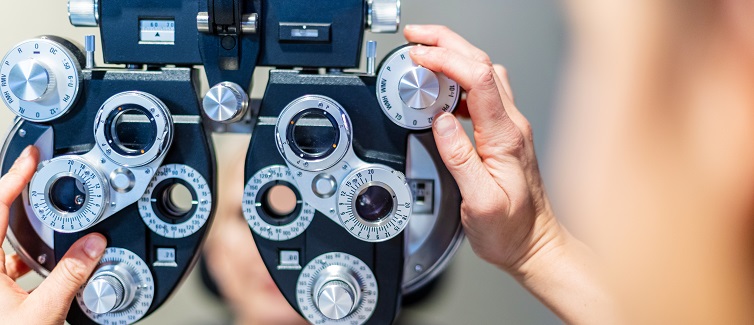Do you hold books at arm’s length when you read? Squint at your computer screen? Do street signs sometimes seem blurry?
If you answered “yes” to any of those questions, you may need glasses. And if so, you’re hardly alone. According to the American Academy of Ophthalmology, more than 150 million Americans use corrective eyewear.
Never Miss a Beat!
Subscribe to Our HealthBeat Newsletter!
Thank you for subscribing!
You can now select the specific newsletters you'd like to receive.
You are already subscribed.
Subscribe to more newsletters in our email preference center.
Sorry, an error occurred. Please try again later.
Get Healthy Tips Sent to Your Phone!
Do I Need an Eye Exam?
Even if you had perfect vision as a teenager, your eyesight is likely to change over the years. For many people, changes become noticeable in middle age.
In addition to adults with pre-existing health conditions and/or a family history of eye disease, eye doctors recommend periodic eye health exams for everyone. Regular eye exams can help you see your best and catch problems before it’s too late.
Here are some of the most common signs you may need an eye exam.
Squinting and frowning
Do you need to make a face to read a sign, or recognize a person across the street? That’s a classic sign of myopia, or nearsightedness.
If you’re nearsighted, objects far away appear blurry, while those close up seem clear.
Holding objects close to your face
Nearsighted people typically bring objects (like the price tag on a shirt) close to their face to see them.
Nearsightedness can be mild, moderate, or severe. It’s caused by a natural change in the shape of the eyeball. Eyeglasses or contacts can usually correct nearsightedness.
Trouble reading fine print
If words on a page blur together, you may suffer from hyperopia, or farsightedness. Farsighted people see objects at a distance more clearly than objects close up.
Some farsightedness starts in childhood, although normal growth of the eye sometimes corrects the problem. If farsightedness doesn’t improve or gets worse, eyeglasses can help.
Presbyopia, or age-related vision loss, is similar to farsightedness but emerges in middle age. It happens when the lenses in your eyes gradually thicken and lose flexibility, decreasing your ability to focus on close objects. Eyeglasses can help you see more clearly.
Holding a book at arm’s length
Farsighted people have difficulty focusing on objects near their face. Being farsighted makes it difficult to perform close-up tasks like reading or stitching.
Difficulty seeing in dim light
If you’re nearing middle age, you may notice your eyesight getting worse in low light. That’s a classic sign of presbyopia, or age-related vision loss.
At around 40, our eyes take longer to adjust to changes in light. It’s a natural part of aging, no matter what your vision was like before.
Worse vision when you’re tired
Again, blame aging. When you’re young, the muscle surrounding the lens in your eye expands and contracts to focus. With age, the muscle doesn’t work as well, especially when you’re tired.
If your age-related vision loss is mild, you may be able to wear over-the-counter “readers” for close work. But if you’re having trouble seeing both up close and far away, your eye doctor may prescribe bifocal or progressive lenses.
Bifocals are lenses with two prescriptions. The top prescription corrects distance vision at eye level and above, while the bottom one corrects close-up vision.
Progressive lenses have three prescriptions in one pair of glasses. They improve your vision up close (reading or sewing), at middle distance (working on a computer), and far away. Unlike biofocals, the prescription changes gradually from one section to the next, so there is no transitional line between prescriptions.
Headaches and eye strain
If you need glasses, you may get mild headaches after reading or being on the computer for extended periods. Headaches and eye strain are a symptom of both near-sightedness and farsightedness. They often disappear when you get glasses.
Sudden changes in your vision
Some symptoms can be a sign of more serious eye problems. You should see an eye doctor right away if you have any of the following:
- Sudden flashes of light.
- Floaters that weren’t there before.
- Sudden changes that happen in only one eye.
- Any loss of vision that lasts more than a few seconds.
- A dark curtain or veil across part of your vision.
Can I Find Glasses That Look Good?
If your doctor prescribes eyeglasses, you have many styles to choose from. Today’s frames are sleek and sophisticated, with many colors and shapes to fit your face and personality.
UPMC Vision Institute Optical Shops offer a wide variety of up-to-date designer frames. And with UPMC’s Virtual Frame Try-On, you don’t even have to leave your home to shop.
Visit the website to browse an array of different looks. By enabling your device’s camera, you can take a photo of yourself and “try on” various frames. In a few minutes, you’ll be on your way to a stylish look — and better eyesight.
Sources
About UPMC Vision Institute
The UPMC Vision Institute is a national leader in the treatment of eye diseases and disorders. We seek to improve and restore your vision to help your quality of life, diagnosing and treating a wide range of conditions in both children and adults. Our treatments include both surgical and nonsurgical options. We also offer routine eye screenings and have full-scale optical shops. Find an eye expert close to you.
